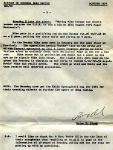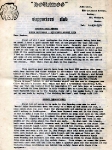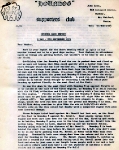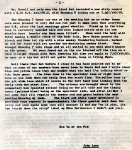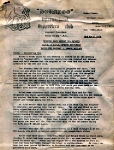
As told exclusively to
1969 saw the debut of Houndog 4 and the Cadillac motor was getting quicker and faster. Mike had a thrilling race with Wild Bill Weichelt in Dos Palmos through the Piccadilly underpass then sadly in 1971 he had a top end crash, writing the dragster off.
A new dragster was built for 1972 and Roy Phelps gave the Houndog team a 354 Dodge hemi which they managed to break. The following year Roy gave them the 392 Chrysler hemi from Firefly. A longer chassis was built and with bigger boots fitted and Mike got the slingshot into the sevens.
The beautiful new rear engined dragster Houndog 8 debuted in July 1974 and Mike was soon into the sixes. He also surprised everyone after its first burnout when he reversed back to the line. This was the first fueller in the UK to be fitted with a reverse gear.
Mike's story was produced by John Hunt and Nick Pettitt and published by Eurodragster.com editor Simon Groves.
For 1969 the dragster was rebuilt and renamed Houndog 4. Nobby decided the old blower on the front really wasn’t a good idea anymore. We got a Wade blower and mounted it on top of the engine, and we needed a set of pulleys. Nobby would give me blocks of aluminum to make them. Now bearing in mind Polypenco was a plastics company, anyone who came by my section would see at the back of the lathe a pile of aluminium swarf. I made all the pulleys, machined the manifold and Nobby installed his own injection which he called Hill’s injection, and it ran really well. In fact, 140 mph at 9.7 was the best. We were only running on methanol, we were poor old boys. We still worked for a living; it was all amateur stuff.

For 1969 the front bodywork and tail section were removed, and a top mounted blower fitted. It was now called Houndog 4. |

Moving Mike had swapped his white overalls for a silver fire suit. |
Nobby wanted to make his own body panels and I said you need what’s called an English Wheel to bend the sheets of aluminium. Being so practically minded he built his own out of a few iron bars and a couple of wheels. It was very crude, but it worked.
I did all my work in the workshop at work. Nobby did all the building of the cars in his workshop which he preferred to do. He was a brilliant fabricator. I used to go over to Nobbys twice a week and catch up on what was needed.

New full bodywork on Houndog 4 for 1970. |

Playing catch-up to Tony Anderson in Trouble. |

Smoking as usual. |
Later on we did a trailer for a film which involved closing the Piccadilly underpass in London and it was me and Wild Bill Weichelt in Dos Palmos. We put the cars in the underpass, I can't remember what the film was called but there was a bloke called Bob Todd, a comic actor. We raced out of the underpass with the parachutes out, the noise was unbelievable in the tunnel and there were huge crowds and great interest from the press all phoning up wanting to know about it. I remember Bill overshot and ended up going further into the streets near the traffic with the chute lying on the road.

|

|

Wild Bill Weichelt in Asmodeus went a bit too far ending up in the London traffic. |
All the time we were increasing the power out of this old Cadillac. One day it broke going only a yard of the start line, we’d fitted bigger tyres and I thought what’s that. We took the sump off and the camshaft was in pieces. It had blown the crankshaft through its journals and smashed the block and the whole engine was smashed to smithereens. We thought we’re on the right track here, we’ve got lots of power. Nobby made supports under the main bearings to support the crankshaft and we found a company who supplied us with a new camshaft and we had the conrods boxed and welded and made teflon pins for the pistons.

The twisted Houndog 4 after the crash. Philip Eeles pic. |
Then unfortunately there was a nasty accident. We weren't running the inner tyre like the Americans, and I suffered a puncture. It was May 1971 and I was racing Allan Herridge in the Gloworm Capri funny car and we were alongside each other. Suddenly the left-hand tire went down and the car turned sharp left and we were in the barrier before you could even blink. It was a hell of a thump. It took me about five minutes to get out of the car, nobody came, I just sat there. It was totally wrecked, a total write-off. Nobby said not a weld was broken on that car. He was a top-notch welder, we used to say he could weld chewing gum.
So, we were a bit stuck. The engine was fine, just the chassis and body work was all bent and twisted. After four years of nurturing and building the engine, Nobby sold it and regretted it afterwards. The engine was what really interested me a lot.
Then the money started to creep into the sport, as it does. Tudor Rose started it all, along with the 427 Ford powered Commuter and Clive Skilton with the ex-Allard 354 hemi dragster. Then Roy Phelps started building cars.
Roy came along and gave us a 354 Dodge hemi. I think it was an ex-marine engine, so Nobby built another car with the hemi for the 1972 season. It was built at a concrete works somewhere and we called it the blue car, which was actually Houndog 5. It was built as a smoker, and it did smoke the tires well off the line. I loved that car; it really was a great car to drive.

The Houndog Team had a new 354 Dodge Hemi powered Fueler for '72. |

Starting up on the rollers as Nobby checks the engine. Vauxhall Cresta push car had matching paint job. Pete Blake pic. |

That's not a burnout, this is the way Houndog preferred to leave the line in '72. Phil Herrick pic. |

Nobby adjusts the injection with his flip-flops on. Phil Herrick pic. |
The 354 broke then Roy gave us the 392 Chrysler hemi from Firefly which we fitted for 1973. The chassis was also lengthened, and we fitted canard wings to the sides under the engine and small wings on the front. It was resprayed in shades of orange and blue and became Houndog 6. The smoker tyres were swapped for bigger boots and it used to lift the front wheels leaving the line. We went to British lead mills and had some paddles made up of solid lead. I think they weighed 30 lb each and we strapped them to the front axle. This helped but not totally.

Houndog 6 debuted in 1973. Pete Blake pic. |

It got into the sevens at the G-Max Meet on June 17th with a 7.32 at 196mph |

It had been repainted, lengthened and fitted with the ex-Firefly 392. It also now sported wings and bigger boots. |

Houndog book. |
That flame burnout with Houndog 6 on the front cover of Nobby’s book set fire to the roof of the iron building behind the start line known as the barn. It must have caught the moss or something as it burnt for a bit. One lad got a lump on his hand, so I wrote to him and sent a photograph as well.
The real problem was money because we were amateurs. Roy was very kind; he gave us the engine. We couldn’t do what’s done today, do a run, strip it all down and build it up again, we couldn’t do that and only stripped an engine down if it broke and of course over a period of time the engine would lose power and wear out. I understood they used to rev to around 8000 rpm which is an awful lot for a big V8.
So, all the time it was running, we continued to run it which hurt the times. That 392 ran a best of 7.52 at 196 mph but as time went on it started to run 185 mph and 7.7s, it slowly deteriorated because you haven't got all the power. That’s why the Americans would strip the engines down every run, almost making it a brand-new motor, you know, but we couldn’t do that, all we did after a run was to change the oil when we were using nitro.
At one time we lost a conrod on the 392 and severely damaged one of the cylinders. Nobby got hold of a small boring machine and bored it out then used a diesel liner which I machined so it was a press fit in the bore.

Mike with John Lees founder of the Houndog Supporters Club. |

Nobby, Peter Hart and Mike... on the left is either Owen Hayward or Dave Bates. |

On the left is John Lees again |
I remember the NDRC were a breakaway group from BDR&HRA. Anyway, I sneaked into one of the NDRC AGM meetings at Luton and they were talking about the last race meeting and said we all know they take it in turns to win, you know it was Herridge, one week then Hutcherson the next week. I thought it was a complete pack of lies. I didn’t understand why they said it and I wanted to say something but as I wasn’t supposed to be there I didn’t. I did tell Nobby about it afterwards. We all joined the BDR&HRA as that was the only one and that made sense to me. I couldn’t see the point of having two drag racing clubs
People thought some racers were being favoured, perhaps they were, there was no question that Roy Phelps was favouring his own cars of course and the other cars that performed and who turned up every fortnight, you know. We used to race an awful lot. It used to be at least twice a month and we’d go for four-day weekends, bank holidays and you’d be racing all the time and to continue as I said earlier because of the amount of maintenance we couldn’t do what they do today.
What a lot of people didn’t know, Nobby was colour blind. I was at Oldings one Sunday and he was painting the engine block a strange orange colour. He said to me what do you think, and I said yeh red suits it. I didn't know what to say but it stayed like it. That’s why Houndog 6 was an odd pinkie colour.
My mate Little Will, as we called him, worked for a firm who did screen printing. We bought a load of t-shirts and he did the Houndog logo and funnily enough we had a huge blue trailer which Nobby built and my young brother Peter painted a big Houndog on it which took him ages to do but he really loved it. He’d painted dragsters all over his bedroom walls.
When Tony Nancy came over for the ‘73 Internationals we drew him in the first round and he was running 6.8s and we were in the sevens. The only thing we could do to beat him was a holeshot but the car went up at 45 degrees off the line. I kept my foot in it recording 7.72 at 151mph with no damage but Nancy passed me with a 6.90/213mph.

Giving the barn fans a blast of nitro fumes and bleach spray. |

Wheels up ahead of Tony Nancy. Barry Graham pic. |
At the same time Roy Phelps bought Paula Murphy’s Funny Car and gave it to Nobby to run. This became Houndog 7 and Owen Hayward got to drive it. Nobby also wanted a rear engined Top Fuel car to replace the aging slingshot. He liked the look of Tony Nancys car and asked him if he’d sell it. He would but the price was too high so he went back to him and asked if he could possibly have the plans for the car and Tony sent them to Nobby soon after returning to the States.

Paula Murphy's Ed Pink powered '71 Duster. Pete Robbins pic. |

The Houndog Team had it painted in their colours for '74. |
Nobby then built the rear engined car for me to drive and that was Houndog 8. Not many people knew, and it doesn’t matter now, but it wasn’t built out of light weight tubing, it weighed 2000 lb, you could barely push it. It was all down to the high cost of light weight tubing but the engine was a very powerful Ed Pink 426 and it managed to get under seven seconds.
There was a deal between Nobby and Roy Phelps with the slingshot Houndog 6, they said let's give Harold Bull a go in it. My mates Peter, and big Alec were doing the mechanics for me. There was a problem with the rocker covers and the gaskets would leak oil. Pete and Alec had a technique where they tightened it up just enough otherwise too tight and it spreads the gasket out then it leaks oil. They told the people working on the car for Harold but they still over-tightened the rocker covers and that’s what happened. Oil came out onto the tires and Harold’s goggles and he lost control at high speed and crashed. They didn’t listen to the advice given. It was such a shame and everyone was so upset. The chassis was probably scrapped, but the 392 lived on as it went to Phil Elson’s Sneaky T altered as he had just blown up his engine.
Houndog 8 debuted in July 1974 at the Drag Racing News Trophy Meet, the same meeting that saw Harold crash Houndog 6. Everyone was surprised when I reversed after the burnout. This was the first fueler in the UK to have a reverse gear fitted, up till then the cars were pushed back. After a first checkout pass I clocked a strong 7.31 and at the next meeting ran my first six.

Houndog 8 debuted in July 1974. |

It was soon in the sixes. |

Push Car, Funny Car and Fueler all in the same colours. |

Mike wins his first race with the rear engined car against Alan Herridge in Firefly. |
We reckoned the 392 was producing around 2000 bhp and the 426 that was in the rear engined car was probably producing 3000 bhp. If you wanted to run from 7.5 to 6.9 you needed another 1000 bhp, it was as simple as that.
Owen Hayward and I were totally different people. He wasn't what I would call as much of a team member as the rest of us because he was Nobby’s boss at Oldings you know. He had an agenda which I knew full well and when the Paula Murphy Funny Car came along it was pretty obvious that he was going to drive it and I wasn’t and that’s where we started to go our separate ways. After one year Oldings had sponsored Nobby’s car. They wouldn’t have sponsored it if I was driving but because both Nobby and Owen worked at Oldings together they sponsored the funny car, that’s how it went.
We never really got on at all. I went to his stag do and he never turned up. It was a place in Watford, there was a band playing and a meal and all the rest of it. I asked Nobby where’s Owen? None of us got invited to his wedding, that's just the way he was. We never fell out as such.
Nobby never drove any of the dragsters and I could never understand why. He used to say I’m too big to get in there. I think he could have and was a good driver but it was all about the build for him and the achievement.
So I’d been racing for nine years and there comes a time when you think well, I only ever had one bad accident and you could tell. I stopped at the end of the 1974 season and of course it was some years later Allan Herridge got killed and there were a few other bad accidents when the car just veers straight into the barrier which happens in a second and there’s nothing you can do about it. This said I did really enjoy driving all the cars, it was really good fun but eventually it got too expensive. I was a total amateur, I never got a penny out of it in fact it cost me money. Relative to today it’s not a lot of money but over the nine years I raced you’re probably talking a few hundred quid.
There came a time of self-preservation and I had to get settled down to a job. I was quite successful as I finished up as machine shop manager in Polypenco’s branch in Manchester where I met my wife Denise and I worked for the company for 25 years. I was there for four years then came the depression in the 1980’s and the company closed the Manchester branch, and I came back here and was made line manager of the PTFE department and back earning decent money again.
Brian Taylor arranged a reunion at Santa Pod in 1996 with Custom Car for the 30th anniversary. The Commuter Dragster had been restored and he wanted me to go with several other old dragster drivers there. Ken Cooper was there and it was the first time I’d seen him for 20 years or more. We had our pictures taken with the Commuter Dragster. I’d been friends with Ken since day one, we poked fun at each other all the time.
Last time I saw Nobby and Ann was at the Shuttleworth museum, Old Warden where Nobby would take his old 1963 dragster to an NSRA street rod show they held there each year. I used to go and help him set it up. What isn’t known is the year before covid, Nobby said I’m finishing this car now and I want you to drive it at the Dragstalgia event. Then covid came along and it never happened.
He told me and I’m not so sure about this, he said it’s a replica, I remade it exactly the same as it was originally. If you see the pictures it is exactly the same, I thought it was the original car but it can’t have been I reckon. We were going to just trundle up and down the strip to get the engine running but covid killed it all unfortunately.
I’m really pleased I did what I did and really enjoyed driving all the cars. I listen to people talk about this and that and think you’ve been nowhere and done nothing. I love all sports but I'm not good at any of them. I’ve played golf for 60 years and I’m absolutely useless.
Many thanks to Pat, Brian, Peter Hart, Big Alec, Will and Rose and everyone else who supported me, and many thanks to the legend Nobby Hills.
Houndog history video: click here
Magazine articles: click thumbnail to enlarge, click back to return.
Gallery: click on any thumbnail for a large image.
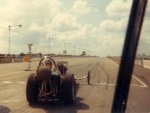 |
 |
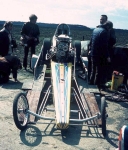 |
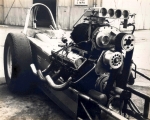 |
 |
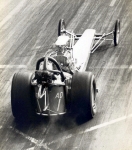 |
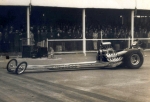 |
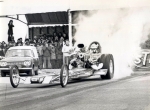 |
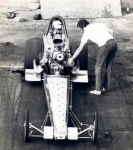 |
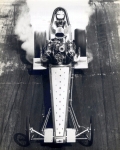 |
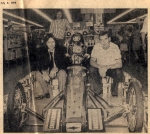 |
 |
 |
 |
 |
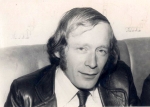 |
 |
 |
 |
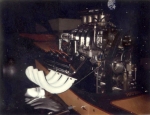 |
 |
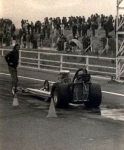 |
 |
 |
 |
 |
 |
 |
 |
 |
 |
 |
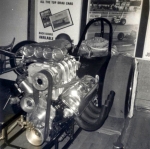 |
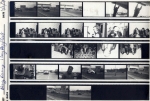 |
 |
 |
 |
Back to pioneers index
Back to News page













